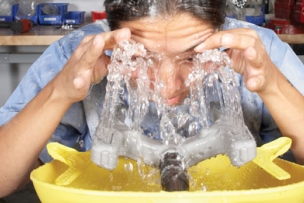The Sqwincher formulation is the result of research and development that goes well beyond quenching thirst to deliver rehydration for the toughest of work conditions. Sqwincher is a higher level of hydration, with a variety of enjoyable flavors and formulations that address worker health conditions and rehydrate and refuel the body by replacing fluids and essential electrolytes lost to dehydration and physical exertion. Sqwincher is Hydration That Works.
Question: If I start showing the signs of heat stress, what do I need to do to stay safe?
Answer: Heat stress occurs when the core temperature increases so significantly that the body is unable to cool itself by sweating. Tolerance to heat varies by individual but is affected by age, weight, physical fitness, hydration level, use of alcohol and medication, and pre-existing medical conditions, but anyone who works in the heat for prolonged periods can succumb to heat stress.
Factors that increase the risk include:
- High temperatures and humidity
- Direct sun exposure and no breeze
- Heavy physical labor
- Lack of acclimatization to a hot workplace
- Low fluid intake
- Waterproof clothing
Both employers and workers should understand the symptoms of heat stress and be able to identify when you or someone else is at risk for a heat-related illness. If that’s the case, use these steps as a guide to help manage the situation.
- Move to a Shaded Area
Whether it’s under a tree or under a break tent, it’s essential to give the body a break by moving out of the sun and into a cooler resting place. Particularly for those with heat exhaustion, it’s advisable not to return to work for the remainder of the day. - Remove Outer Layers of Clothing
Removing unnecessary clothing (including jackets, shoes and socks) can help cool a worker down. It will also allow cold compresses to reach a larger area of skin. - Cool Down with Fans, Mist and Ice Bags or Cold Towels
The goal of this step is to lower the worker’s internal body temperature. Employers should ensure that every worksite has a “cooling area” (ideally with a fan), as well as a supply of ice packs for emergency situations. - Provide Cool Drinks for Rehydration
Individuals suffering from heat illnesses are often experiencing some level of dehydration, too. Encourage them to take frequent sips of a cool drink (ideally water) to help replenish fluids lost in the heat. - Alert a Supervisor or Call 911
If someone is suffering from heat stroke and exhibiting signs of confusion, loss of consciousness, and seizures, emergency services should be called immediately. Do not administer fluids to someone with heat stroke. Although it's natural to want to help them rehydrate, the symptoms of heat stroke mean that they cannot drink or swallow safely. Those suffering from heat rash, heat cramps, or heat exhaustion may also need to seek medical treatment, depending on the severity.
If you’re at all in doubt about how to proceed, don’t hesitate to seek the help of a medical professional. Every year, thousands of workers become ill or even die from heat-related conditions. Educate yourself and take action to ensure you aren’t one of them.
Previously featured on safeopedia.com.





Talk to Us!
Leave a reply
Your email address will not be published. Required fields are marked *